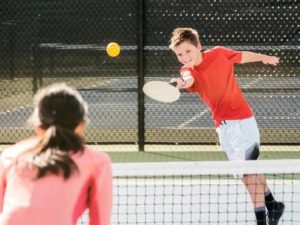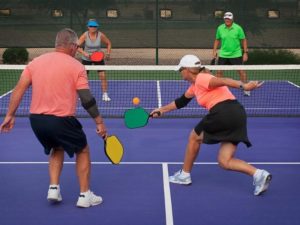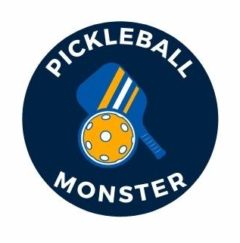How to Play Pickleball
After learning about the history and basic information of pickleball, it’s critical to learn how to play the game’s fundamentals. While you may certainly learn this on the court, it is preferable to have some advanced reading first and then apply them later.
Pickleball is available in singles and doubles formats, with doubles being the most popular. Singles and doubles are played using the identical rules, but the scoring differs somewhat.
The best two games out of three are played in each match. Each game is played to eleven points, with a two-point victory. Alternatively, if there’s only one game, it’ll be played to fifteen points with a two-point win.
Pickleball is played on a 44‘ x 20‘ rectangular court. A low net divides the court into two halves.
In a pickleball court, there are two sidelines, two baselines, a centerline on each side, and two 7-foot non-volley zone lines, forming an area popularly known as “the kitchen.”
Each side is divided into two service courts, the left service court and the right service court, by the center line. This allows players to see where they should serve the ball and where they should stand while serving.

How to Play Pickleball Singles
You must adhere to a number of rules and strategies when playing pickleball. You’ll keep improving if you understand them and put them into practice.
- The games are played to a total of 11 points (win by 2). The server is the only one who can score points.
- If the receiver makes a mistake, the server receives a point. If the server makes a mistake, the server loses the serve.
- The game begins with the server on the right side of the court. If a point is scored, the server changes sides and serves from the left side of the court. When the server’s score is even, the server will serve from the right side of the court in this manner. The server will serve from the left side of the court if his or her score is odd.
- The serve, using the pickleball paddle, must be an underhand serve, with the ball contacting the server below the naval. The serve must be made from behind the baseline with both feet. After the serve is struck, neither foot may touch the baseline or the court.
- The serve must be delivered diagonally opposite the opponent’s service area. The serve is termed “short” and a fault if it makes contact with any area of the non-volley zone line.
- Before the opponent can return the serve, it must bounce, and the return must bounce before the server can return it (double-bounce rule). The following hits can be made either before or after the ball has bounced.
- Except in the event of a let, the server can only make one service attempt (the ball hits the top of the net, but still lands in the proper service court).
- Pickleball players in the non-volley zone or on the non-volley line are not allowed to strike the ball until it has bounced.
- The ball is deemed “in” if it makes contact with any part of the sideline or baseline.
- It is a fault if the ball is hit into the net or out of bounds. It is the receiver’s fault if the ball bounces twice before being hit by the receiver.
- It is a fault if a player, a player’s clothes, or a player’s paddle touches the net while the ball is in play.
- It is a fault if the ball strikes a player or the player’s clothing. A mistake occurs when the ball strikes the ceiling, wall, or any other permanent object before landing in the opponent’s court.
Singles Pickleball Scoring
Pickleball singles scoring is comparable to doubles scoring, with the distinction that there is no second server, as the name implies. As a result, the server merely announces two numbers: the server’s score and the opponent’s score.
The score in singles pickleball is composed of only two numbers (for instance, 8-3). The first number is the score of the server. The receiver’s score is represented by the second number.
The server should serve from the right service court if the score is an even number. Alternatively, the server should serve from the left service court if the score is odd. The server’s score is first, followed by the receiver’s score.
Single Pickleball Kitchen Rules
The “kitchen” is a slang phrase for the non-volley zone in pickleball. This is a part of the court that extends to each sideline and is 7 feet away from both sides of the net.
The basic kitchen rule is that you cannot volley a ball while standing in, or otherwise making contact with, the kitchen zone or kitchen line. A volley is a fancy term for striking the ball in mid-air before it lands. The start of a volley is included in this.

How to Play Pickleball Doubles
- The games are played in a best-of-three format. All games are played to 11 points, with a two-point victory.
- The serving team can only score a point and not by rally scoring.
- All serves must be made underhand, with the ball being touched below the waist level.
- All serves must be made into the diagonal service area on the opposing side. If you don’t do so, the serving team gets a fault.
- Each player is only permitted one serve attempt.
- At the start of the game, only one player from the original serving team gets a turn to serve. Both members will have a service turn before handing the ball over to their opponents for the remainder of the match.
- The server will continue to serve from opposite sides of the court until they lose a point.
- In the game of pickleball, the receiving team never switches sides.
- Both teams must take their first rally shot right away. The Double Bounce Rule is what it sounds like. Once each of teams have done so successfully, “volleying” is also now legal.
- Unless the ball has actually bounced on their side of the court, no player is allowed in “the kitchen” or “no-volley zone.” An example of this is a player landing in the area after a volley.
- On a team’s side, the ball may only bounce once. The point is lost if there are many bounces.
Doubles Pickleball Scoring
The score in doubles pickleball is made up of three numbers (for instance, 0-0-1). The first number is the score of the serving team. The second number is the score of the receiving team. The server number, which is either server #1 or server #2, is represented by the third number.
In doubles pickleball, for example, a score of 9-5-1 indicates that the serving team has 9 points, the receiving team has 5, and the serving team is on server #1.
Doubles Pickleball Positioning
The player on the right side (even court) serves to the diagonally opposite court at the start of the game.
If a point is scored, the server shifts to the left side (odd court) and serves to the court diagonally opposite. When a point is scored, players on the serving side continue to move from right to left or left to right.
Unless a point is scored, players on the serving team do not switch sides. The receiving side does not switch sides at any time.
